RENA Vitro™ AOP system
High-performence AOP system for process and wastewater
RENA Vitro™ is our patented catalytic advanced oxidation processes (AOP) which offer a powerful treatment solution to effectively:
- treat highly contaminated, difficult process- and wastewater (COD < 50 000 mg/l) as measured by TOC, COD or BOD (organic content) and/or
- decompose refractory harmful organic chemical compounds partially or fully, e.i. complexing agents and metal complex, without producing additional harmful by-products or sludge.
In AOPs, the oxidation of organic matter is primarily through reactions with hydroxyl radicals. A hydroxyl radical is the most powerful oxidant available (see table below).
Since the oxidation power is stronger, the major difference to common oxidation is higher efficiency, ability to decompose more difficult substances and shorter process time. The AOP process decomposes tough substances partially or fully to harmless or less harmful substances, for instance to carboxylic acid, carbon dioxide, nitrogen, salt and water.

Our hydroxyl radicals are produced by combining ozone (O3) and a patented catalyst. Sometimes, ozone is used in combination with ultraviolet (UV) or hydrogen peroxide (H2O2) to create hydroxyl radicals. Synergy occurs, “1+1=3”, making the combination more effective than using them separately in series. AOP multiplies the power of oxidation.
The size of a RENA Vitro™ starts from 3 times EUR pallet, depending of the flow.
| Oxidizing Agent | EOP (V) |
|---|---|
| Hydroxyl Radical (OH∙) | 2.80 |
| Oxygen atom(O) | 2.42 |
| Ozone (O3) | 2.07 |
| Hydrogen peroxide (H2O2) | 1.78 |
| Hypochlorite | 1.49 |
| Chlorine (Cl) | 1.36 |
| Chlorine dioxide (ClO2) | 1.27 |
| Oxygen (O2) | 1.23 |
Benefits of AOP
- Very powerful oxidation
- Fast oxidation
- Reduces the total amount of waste
- Reduced toxicity and partially or fully mineralization of contaminants
- Does not produce new compounds that require further treatment such as chlorine byproducts
- Does not produce sludge as with physical chemical processes
- Non selective oxidation allow for the treatment of several contaminants at once
The design of a AOP must be tailored to the chemistry of a specific application.

